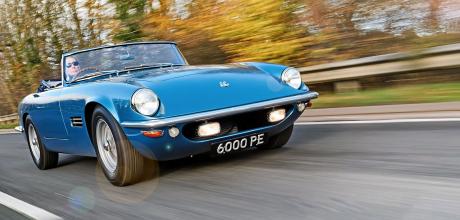1963 AC MA-200 Prototype
This prototype gives a glimpse into an alternate future for AC, had it not been consumed by America’s appetite for Shelby Cobras. Let’s find out if it was it good enough to change history.
Words IVAN OSTROFF
Photography GUS GREGORY
Driving the prototype that could have sent AC in a new future direction
The Gentleman’s Cobra
Driving the prototype MA-200 that promised a high-tech future for AC
Early in the Sixties the motoring world was in awe of AC’s mighty Cobra. But plans were afoot in Thames Ditton to replace the ageing AC Ace-based design. Although there were many changes under the skin of the AC 289 MkII to strengthen it in order to handle the power of the Ford 289ci V8 engine, it was still a beefed-up AC Ace. So, while the intention of AC Cars was to build and sell completed Cobras in Britain and Europe as soon as production for the Shelby operation allowed, it was also planning for the future.
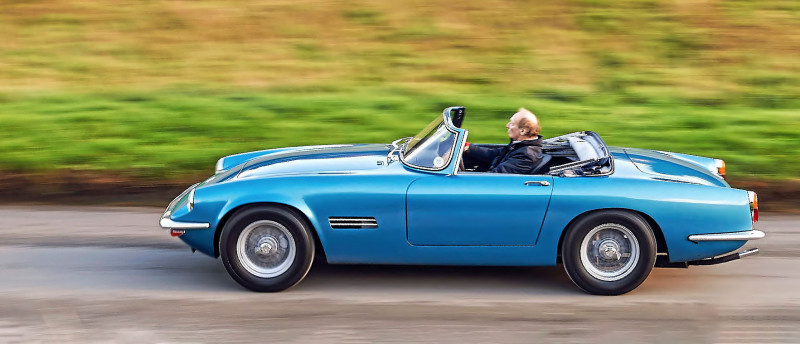
‘Field removed the HiPo 289 and dropped in a highly-tuned 302ci’
That future is before me in the form of an attractive prototype roadster, and I’m about to drive it for a taste of what we ultimately missed.

As I approach the car, it appears reminiscent of a Jensen-Healey at the front, particularly around the headlights, while at the rear there are shades of Alpine and Alvis. In profile the MA-200 is particularly elegant. Equipped with a potent 4.7-litre High Performance (HiPo) Ford V8, the AC MA-200 has similar performance to the AC Cobra 289 but the prototype’s design looks far less brutal. As I climb aboard, it’s clear that it also has all the creature comforts the general car-buying public would have expected of a production sports car in the day, including wind-up side windows and a proper fold-down hood.
‘Even on damp roads the MA-200 hunkers down and grips well’
I pull the chrome handle and the driver’s door closes easily with a satisfying coachbuilt thud, perhaps benefitting from the extra stiffness from the underlying spaceframe construction. The comfortably upholstered leather seats are adjustable fore and aft but that’s all. As it happens though, the rake seems comfortable enough and with my feet resting on the cast aluminium ACstamped pedals, my hands fall perfectly at ten to two on the woodrim aluminium steering wheel. Being registered in 1963, this car does without seatbelts. In front of the driver are the usual two main instruments: on the right, a tachometer reading from zero to a rather optimistic 10,000rpm and on the left a speedometer topping out at 160mph. In the central binnacle are five minor gauges, with a Smiths clock sited centrally just below.
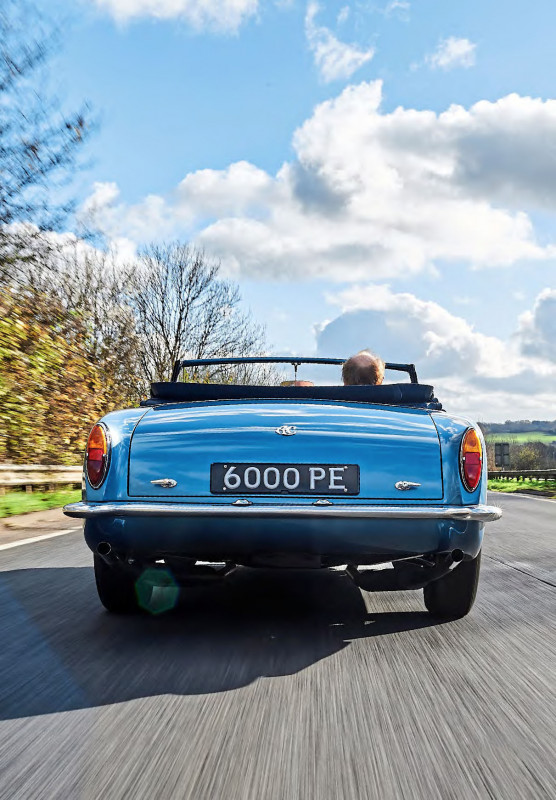
Ergonomics were hardly considered when this MA-200 was assembled, nevertheless, I find that all the controls are within easy reach and instruments are clear to see. The window winder handle does feel rather close to the bottom of the door but this was a prototype, it could easily have been altered for production.
I twist the key, the 4.7-litre Ford V8 fires instantly and settles to a gentle thrumming tickover at about 650rpm. I tickle the throttle just to check response and the engine spools up instantly with a magic double thrum-thrum from the two exhaust pipes exiting aft. Just like a 289 Cobra, the car has a Borg Warner T10 four-speed gearbox, with reverse gear selected by lifting the ‘T-bar’ guard on the gear lever. I feel at home immediately. I dip the clutch and select first, noting mentally that while not actually lightly sprung, the clutch is not as heavy as I’d expected.
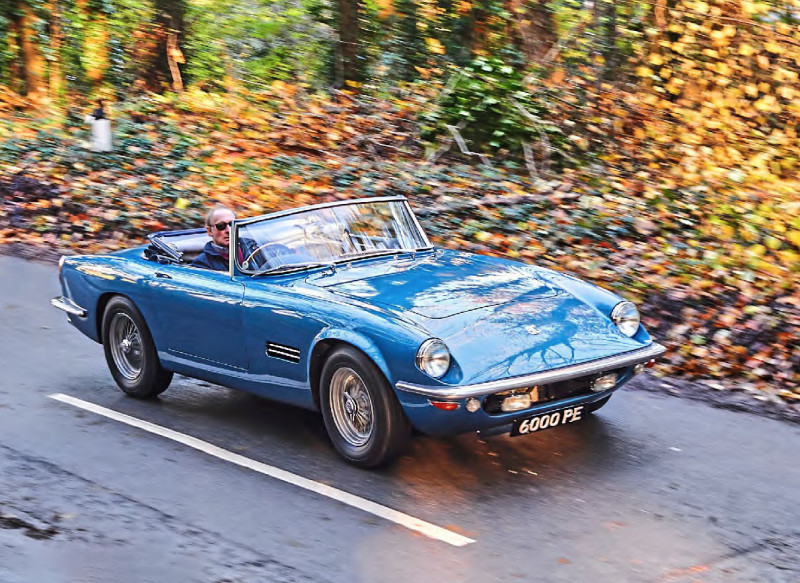
The unassisted steering is on the heavy side at parking speeds, perhaps down to the high-mounted steering rack and its geometry. You really need to employ some muscle to manoeuvre the car around in a restricted space. Eventually I get used to having to feed in the lock gradually once the car is moving. Forget three point turns, rather think five.
Even on these moist slippery country roads, on hard acceleration, the MA-200 hunkers down and seems to grip well.
As the road dries out, I get a little more brave and the AC leaves two black lines behind it with very little persuasion.
The car feels easy to control though – approaching the limit on a corner, the rear tyres chirrup and I can feel the back end wanting to move, but the roadholding is good and even though there is a certain amount of roll, the MA-200 feels secure.
The discs brakes – inboard at the rear, just like Formula One cars of the time – are progressive with plenty of feel, and certainly at road speeds they pull the car up efficiently. The steering on the move is precise and has plenty of feel, though it does weight up as you get into a corner.
As the V8 spins up and passes through 4000rpm the power of the HiPo 289 can really be felt. Zero to 60mph in less than five and a half seconds is still pretty impressive in 2023; sixty years ago it would have been mind-blowing. But the mid-range torque is what really matters when you’re pressing on. Time to blip the throttle and drop down into third, then pull out to overtake. Not just one vehicle, but a whole line in complete safety as MA-200 rockets from 30 to 70mph in less than seven seconds. The cross-country performance of this car is staggering.
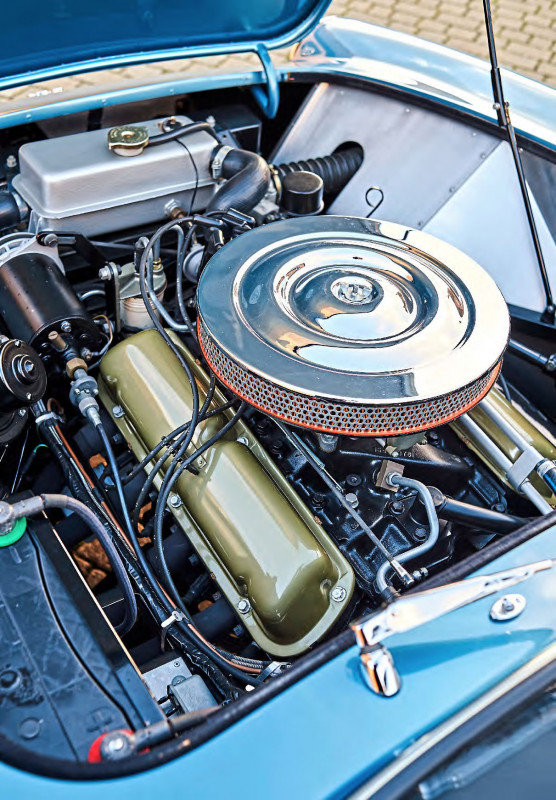
Coming up to a fast corner, I stamp on the brakes. Quite a bit of pressure is required, but the car slows well, the steering loads up, I can sense that the front end has buckets of grip as I haul on the woodrim and prod the throttle a fraction. The V8 responds in an instant – the tail of the car twitches, I correct with a flick, the MA-200 stays true to its course and launches itself out of the corner without getting the tiniest bit out of hand.
Dawdling on a light throttle, the car is geared for around 21mph per thousand rpm in top gear and the V8 power is flexible in all four ratios. In reality, I could drive all day long in top, hardly ever having to change down. But what a waste of fun that would be! The gearbox has synchromesh on all gears so there is no necessity to double de-clutch. But that gorgeous V8 soundtrack is so addictive, heeling and toeing the pedals as I work down through the gearbox is impossible to resist. The lever itself appears to be angled away from the driver but it’s easy to operate and in no time I’m oblivious to its skew.
Have you ever been followed by two large, noisy Harley Davidson motorbikes, running millimetres behind your rear bumper? I remember the very first time that I ever drove a 289-engined Cobra, it sounded just like that and, powered by a similar engine, so does the MA-200.
So how did this car come to be? Well, back in 1962, AC had set about developing an upmarket, luxurious sports car that, with a more compliant ride and a generally more civilised character than the old leaf-sprung, ladder chassis Cobra, would appeal to traditional AC customers. To this end, the prototype was designed and constructed in-house by Zdzislaw Teofil Marczewski, a Polish aircraft engineer whose CV included MiG fighter planes. He gave the car a unique spaceframe chassis, a modern aluminium body and a new 2.0-litre flat-six engine, again of his own design. The car featured wide-angle wishbones, strut type rear suspension, needle roller bearings and a steering rack above and behind the front suspension. Within the company it was known as the ‘Marczewski Special’, but officially it was referred to as the MA-200 – MA for Marczewski and 200 denoting the size of his 2.0-litre engine.
It is believed that several prototype engines were built by AC and that development was fairly advanced but sadly the flat-six unit was disappointing in several areas, including smoothness of running and power delivery. It was thought that more main bearings would cure some of these problems. However when the work was costed, AC was forced to finally drop the proposal.
Concurrently, a Ford 289 HiPo V8-powered AC Cobra was entered at Le Mans. Ford was so delighted with the seventh place result that it gave AC one of the spare engines. So, instead of Marczewski’s stillborn flat-six, the MA-200 was fitted with that very 289 HiPo V8 and prepared for the road with the registration 6000PE. When AC Cars asked for more 4.7-litre V8s, Ford was not forthcoming because of its pending involvement with the 7.0-litre unit that Shelby was about to fit into the Cobras.
When first registered in 1963, the MA-200 was ahead of its time, not least because of its F1-style inboard coil sprung suspension and inboard rear disc brakes. The aluminium body rather resembled the Maserati Mistral, but there is no evidence that the British outfit was working with Frua, despite its hand in the later AC428. In profile the AC looks softer; it also bears some resemblance to Bertone’s Gordon Keeble, the Aston Martin DB4 as well as AC’s own Greyhound. To avoid confusion, the MA- 200 was not the prototype for the later AC428 either; although a likeness might be seen, under the surface they were completely different. The AC428 was built on a lengthened Cobra chassis rather than the MA-200’s sophisticated spaceframe.
In late 1963, AC was doing all it could to produce as many Cobras for Shelby as possible. On top of the failure of the flat-six, Marczewski’s chassis also proved too expensive to produce. But before the MA-200 project was shelved, it was driven to Italy to investigate having bodies made in Modena. On that long drive the car was found to be very unstressed but typical of an undeveloped prototype, it did suffer from overheating as well as suspension tuning problems and front-end float at speed.
Though it was rendered unviable for production, the model’s virtues were clearly appreciated enough, because AC chairman Derek Hurlock took the MA-200 on as his personal car. He continued to use it until 1968 and would often be seen dropping his daughter off at school in the car. In fact Hurlock always had the wish to build a more sophisticated car, and would have been very happy to produce the MA-200. Nevertheless, as we now know, the MA-200 failed to replace the Cobra and the car was eventually set aside with a view to it being broken up.
Step in Roger Field, a local medical student at the time who used to see the car being driven around by Hurlock. Field approached the factory and asked if he could buy it. Eventually, the factory succumbed and Field used the car for several years until he took it off the road pending restoration.
In an interview with Trevor Legate, the author of the book Cobra, Field told him that after he bought the car, he removed the HiPo 289 and dropped in a highly-tuned 302ci V8, which he mated to a ZF five-speed gearbox from an Aston Martin. Nowadays this might seem inconceivable, but back then exracing engines did not have the same collectable value that they do now. When Roger Field died, his family sold the car to Jeremy Davidson in Cornwall. Davidson contacted Hurlock who confirmed that the engine originally fitted to MA-200 was actually one of the first prototype 289 HiPo V8s; Davidson then later relayed this information in a letter to Trevor Legate.
Davidson wrote, ‘Derek Hurlock told me the engine (in MA- 200) was one of the 20 hand-built prototype 289 HiPo units, put together before the “proper” ones went into production. They had a special crankshaft, connecting rods, pistons, camshaft etc, and were balanced to 8000rpm. This seems borne out by examination; the engine in the car has solid valve lifters and dual valve springs, but has crankcase ventilation by road-draft tube (as the Americans call it) and originally had the oil filter tube in the timing chain cover – although since removed but still kept amongst the spares. All this is confirmed by the bellhousing having five bolts instead of the usual six in the production unit.
Also, the carburettor is by Ford, not Autolite or Holley, but is a double pumper which is rather odd. So, MA-200 had the same very special 289 as “39PH”, the famous works-entry Cobra that placed seventh at Le Mans in 1963, but we cannot claim it is necessarily the actual motor, unless paperwork can be dug up to confirm it, which so far has not come to light.’
In summer 2006 the MA-200 was bought by a Mr Gold of Florida. By then it was in a pretty bad way – built as it was for experimentation, not longevity – suffering in particular where corrosion had occurred as a result of galvanic reaction between steel chassis and aluminium body. During a trip to Blighty, Gold met up with the son of one of the AC engineers that worked on the MA-200 build, who gave him a bundle of factory drawings and blueprints. The car was then painstakingly rebuilt to its current pristine condition. The incorrect engine was removed and a correct HiPo 289 replacement with the tell-tale five bolts around the bellhousing. With an earlier order number than the original, it could well have been assembled the same day.
After a thorough three-year documented restoration, in March 2010 the car was invited to attend the Amelia Island Concours, where it won best in class. Later it also gained top honours at the 36th Concours d’Elegance of America. MA-200 was displayed at Salon Privé in London last year by its current carer, DK Engineering of Chorleywood. Having been painstakingly restored, the steel chassis and aluminium body of the MA-200 should be good for some time. A 289 HiPo V8 will be quite trouble free so long as rev limits are respected. However, being a oneoff prototype, the AC MA-200 could be a demanding car to keep if certain items require replacing. The windscreen is unique, as is the rear bumper, which had to be recreated by hand during the restoration. Furthermore, Marczewski tended to make use of what have now become rather scarce parts; the radiator was found to be from an early Jaguar E-type (today difficult to find in non-upgraded form), the rear lights are from the rare Ford Taunus 15M coupé and the fog lights came from a Porsche 356.
Compared with a Cobra, the MA-200 had several advantages. It has a more luxurious interior, a full convertible top, and is more spacious for both driver and passenger. There’s room behind the seats as well as a decent-size boot for touring, although the spare wheel admittedly takes quite a bite out of that. Then there are the advantages of the spaceframe construction. Although the prototype was in open two seater convertible form, a closed fastback was also drawn; in time that might well have followed had the car proceeded to production.
Despite being a prototype, this is a car I could genuinely live with. It’s got everything a Cobra has but with more sophistication, making it more user-friendly that the Anglo-American icon ever was. It might have been less profitable than the cash-cow Cobra, but by canning the MA-200, AC perhaps robbed itself of the accomplished base on which it could have built a stronger future. Such a loss, it makes driving this alternative vision of the past’s future a bittersweet experience.
TECHNICAL DATA 1963 AC MA-200 Prototype
- Engine 4727cc (289ci) Ford HiPo V8, ohv, quad-choke Holley 750 carburettor
- Max Power 271bhp @ 6000rpm
- Max Torque 312lb ft @ 3400rpm
- Transmission Borg Warner T10 four-speed manual, rear-wheel drive
- Steering Rack and pinion
- Suspension Independent all round. Front: lower wishbone, top link, anti-roll bar, coil springs, hydraulic dampers. Rear: lower wishbones, coil springs, hydraulic dampers
- Brakes Front: discs. Rear: inboard discs
- Weight 915kg approx.
- Performance Top speed: 145mph
- Acceleration 0-60mph: 5.4sec
- Price new n/a
- Value today £800,000 approx
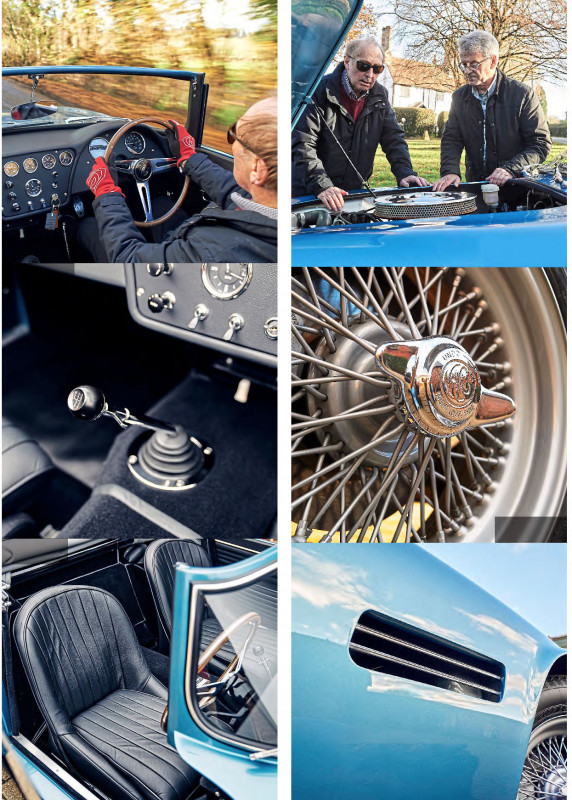
Anglo-Polish parentage, American grunt… Italian styling influences?
Returning the car to its 1963 spec and condition took a lot of work Wire wheel have to cope with a lot of torque from that V8 Design details well-resolved for a prototype.
289 is as faithful to the car’s original unit as is possible today
‘I could drive all day long in top, hardly ever having to change down. But what a waste of fun that would be!’ No brash side-exit exhausts to be found here
Rack design means steering is heavy but communicative. Gear lever is skewed away from driver but still feels natural.
Space behind rear seats make the car a practical tourer
Despite looking like it came from an expert Italian coachbuilder, there’s no evidence to suggest the lines were anyone but Marczewski’s
Cabin is more luxurious and accommodating than a Cobra’s


